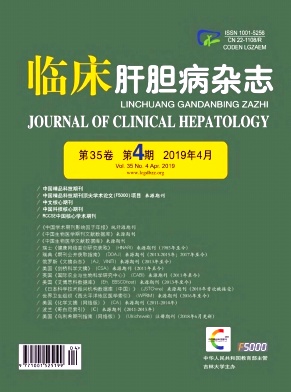|
[1]TAYLOR E, CAITLIN M, HUDSON P, et al. Nuclease-mediated gene therapies for inherited metabolic diseases of the liver[J]. Yale J Biol Med, 2017, 90 (4) :553-566.
|
|
[2] HU YM, JIANG ZF, ZHU FT. Practical pediatrics[M]. 8 th.Beijing:People's Medical Publishing House, 2012:2249-2336. (in Chinese) 胡亚美, 江载芳.诸福棠.实用儿科学[M]. 8版.北京:人民卫生出版社, 2012:2249-2336.
|
|
[3]OLIVER B, KARL H, STEPHEN G. Wilson's disease and other neurological copper disorders[J]. Lancet Neurol, 2015, 14 (1) :103-113.
|
|
[4]STENSON P, MATTHEW M, EDWARD V, et al. The Human Gene Mutation Database:Towards a comprehensive repository of inherited mutation data for medical research, genetic diagnosis and next-generation sequencing studies[J]. Hum Genet, 2017, 136 (6) :665-677.
|
|
[5] COFFEY AJ, DURKIE M, HAGUE S, et al. A genetic study of Wilson's disease in the United Kingdom[J]. Brain, 2013, 136 (5) :1476-1487.
|
|
[6]CHENG N, WANG K, HU WB, et al. Wilson disease in the South chinese han population[J]. Can J Neurol Sci, 2014, 41:363-367.
|
|
[7]AGGARWAL A, BHATT M. Advances in treatment of Wilson disease[J]. Tremor Other Hyperkinet Mov (N Y) , 2018, 8:525.
|
|
[8]CZLONKOWSKA A, LITWIN T, DUSEK P, et al. Wilson disease[J]. Nat Rev Dis Primers, 2018, 4 (1) :21.
|
|
[9]POWEL LW, SECKINGTON RC, DEUGNIER Y. Haemochromatosis[J]. Lancet, 2016, 388:706-716.
|
|
[10]WALLACE DF, SUBRAMANIAM VN. The global prevalence of HFE and non-HFE hemochromatosis estimated from analysis of nest-generation sequencing data[J]. Genet Med, 2016, 18 (6) :618-626.
|
|
[11]GROSSE SD, GURRIN LC, BERTALLI NA, et al. Clinical penetrance in hereditary hemochromatosis:Estimates of the cumulative incidence of severe liver disease among HFE C282Y homozygotes[J]. Genet Med, 2018, 20 (4) :383-389.
|
|
[12]RICKY J, MAYA S, ERICA M, et al. Functional consequences of transferrin receptor-2 mutations causing hereditary hemochromatosis type3[J]. Mol Genet Genomic Med, 2015, 3 (3) :221-232.
|
|
[13]DOROTHEA B, SUNDRELA KM, JULIAN KM, et al. Efficacy and safety of erythrocytapheresis and low-dose erythropoietin for treatment of hemochromatosis[J]. J Clin Apheresis, 2017, 32 (3) :170-174.
|
|
[14]OLDFORS A, DIMAURO S. New insights in the field of muscle glycogenoses[J]. Curr Opin Neurol, 2013, 26 (5) :544-553.
|
|
[15]STONE WL, ADIL A. Glycogen storage disease[J]. Treasure Island (FL) :Stat Pearls Publishing, 2019.
|
|
[16]CHOU JY, KIM GY, CHO JH. Recent development and gene therapy for glycogen storage disease type Ia[J]. Liver Res, 2017, 1 (3) :174-180.
|
|
[17]CRAIG TJ. Suspecting and testing for alpha-1 antitrypsin deficiency-an allergist's and/or immunologist's perspective[J]. J Allergy Clin Immunol Pract, 2015, 3 (4) :506-511.
|
|
[18]DUVOIX A, ROUSSEL BD, LOMAS DA. Molecular pathogenesis of alpha-1-antitrypsin deficiency[J]. Rev Mal Respir, 2014, 31 (10) :992-1002.
|
|
[19]LASCANO JE, CAMPOS MA. The important role of primary care providers in the detection of alpha-1-antitrypsin deficiency[J]. Postgrad Med, 2017, 129 (8) :889-895.
|
|
[20]GREULICH T, VOGELMEIER CF. Alpha-1-antitrypsin deficiency:Increasing awareness and improving diagnosis[J]. Ther Adv Respir Dis, 2016, 10 (1) :72-84.
|
|
[21]GOOPTU B, DICKENS JA, LOMAS DA. The molecular and cellular pathology ofα1-antitrypsin deficiency[J]. Trends Mol Med, 2014, 20:116-127.
|
|
[22]GRUNTMAN AM, FLOTTE TR. Therapeutics:Gene therapy for alpha-1-antitrypsin deficiency[J]. Methods Mol Biol, 2017, 1639:267-275.
|
|
[23]THOGULUVA C, JOHN S. Gilbert syndrome[J]. Treasure Island (FL) :Stat Pearls Publishing, 2018.
|
|
[24]MARUO Y, NAKAHARA S, YANAGI T, et al. Genotype of UGT1A1and phenotype correlation between Crigler-Najjar syndrome type II and Gilbert syndrome[J]. J Gastroenterol Hepatol, 2016, 31 (2) :403-408.
|
|
[25]EBRAHIMI A, RAHIM F. Crigler-Najjar syndrome:Current perspectives and the application of clinical genetics[J]. Endocr Metab Immune Disord Drug Targets, 2018, 18 (3) :201-211.
|
|
[26] LEE J, CHEN H, NI Y, et al. Neonatal Dubin-Johnson syndrome:Long term follow-up and MRP2 mutations study[J].Pediatr Res, 2006, 59 (4) :584-589.
|
|
[27]MEMON N, WEINBERGER BI, HEGYI T, et al. Inherited disorders of bilirubin clearance[J]. Pediatr Res, 2016, 79 (3) :378-386.
|
|
[28]STRASSBURG CP. Hyperbilirubinemia syndromes (GilbertMeulengracht, Crigler-Najjar, Dubin-Johnson, and Rotor syndrome) [J]. Best Pract Res Clin Gastroenterol, 2010, 24:555-571.
|
|
[29]JACQUEMIN E. Progressive familial intrahepatic cholestasis[J]. Clin Res Hepatol Gas, 2012, 36 (1 Suppl) :s26-s35.
|
|
[30]TOGAWA T, SUGIURA T, ITO K, et al. Molecular genetic dissection and neonatal/infantile intrahepatic cholestasis using targeted next-generation sequencing[J]. J Pediatr, 2016, 171:171-177.
|
|
[31]CARIELLO M, PICCININ E, GARCIA-IRIGOYEN O, et al.Nuclear Receptor FXR, bile acids and liver damage:Introducing the progressive familial intrahepatic cholestasis with FXR mutations[J]. Biochim Biophys Acta Mol Basis Dis, 2018, 1864 (4 Pt B) :1308-1318.
|
|
[32]DROGE C, BONUS M, BAUMANN U, et al. Sequencing of FIC1, BSEP and MDR3 in a large cohort of patients with cholestasis revealed a high number of different genetic variants[J].J Hepatol, 2017, 67 (6) :1253-1264.
|
|
[33]KRAWCZYK M, LIEBE R, WASILEWICZ M, et al. Plasmapheresis exerts a long-lasting antipruritic effect in severe cholestatic itch[J]. Liver Int, 2017, 37:743-747.
|
|
[34]HEGADE VS, KRAWCZYK M, KREMER AE, et al. The safety and efficacy of nasobiliary drainage in the treatment of refractory cholestatic pruritus:A multicentre European study[J]. Aliment Pharmacol Ther, 2016, 43 (2) :294-302.
|







 DownLoad:
DownLoad: